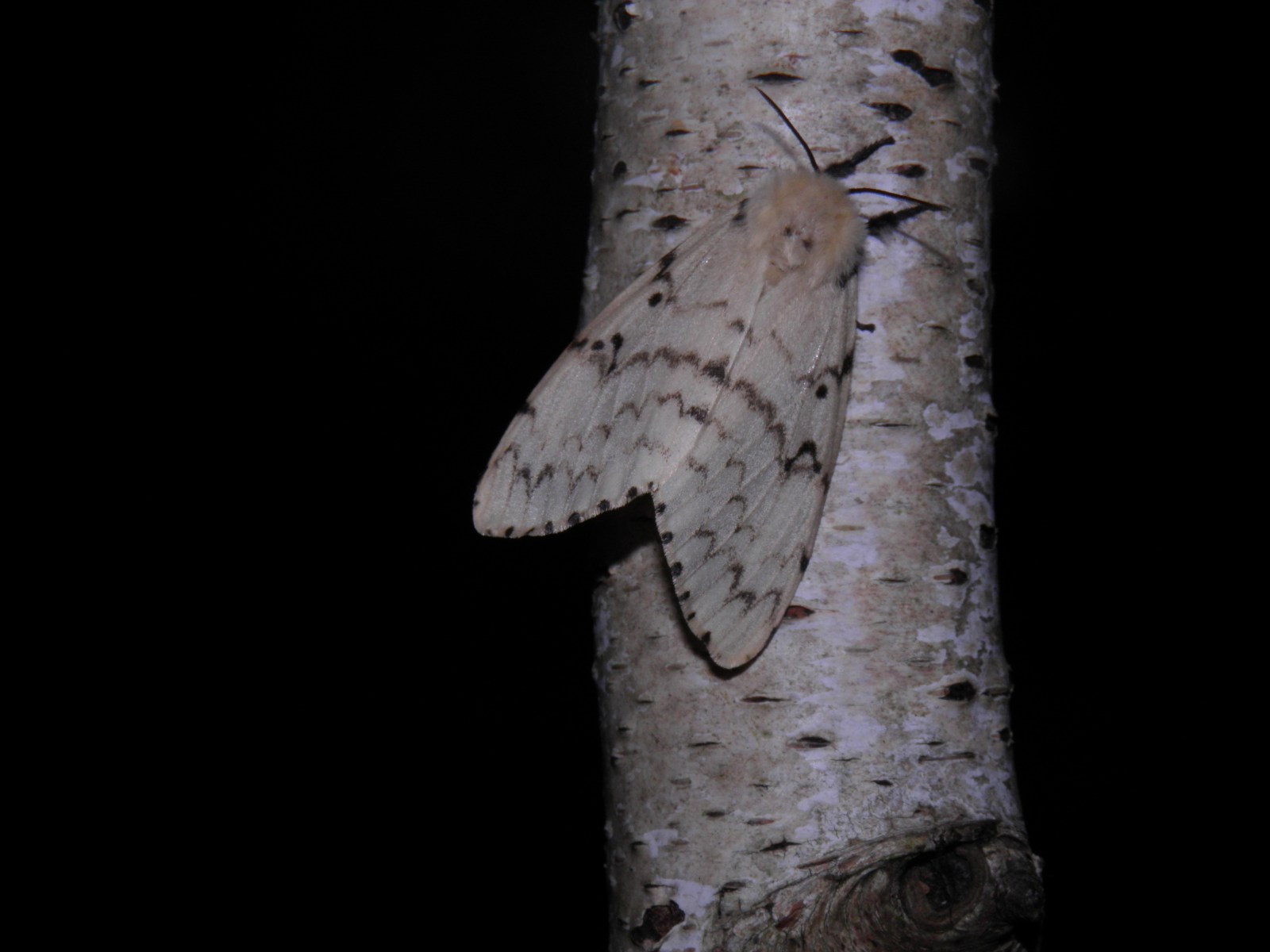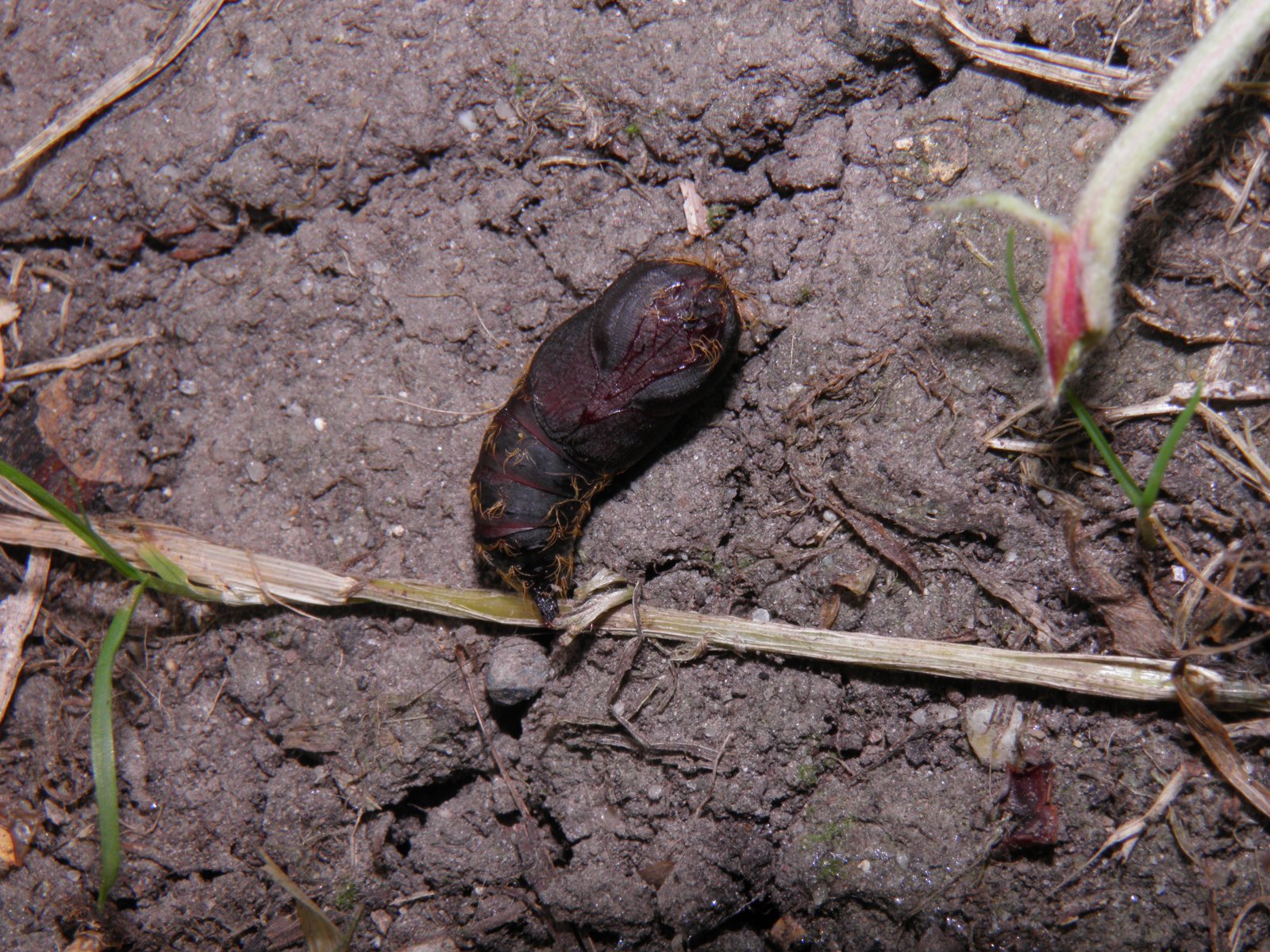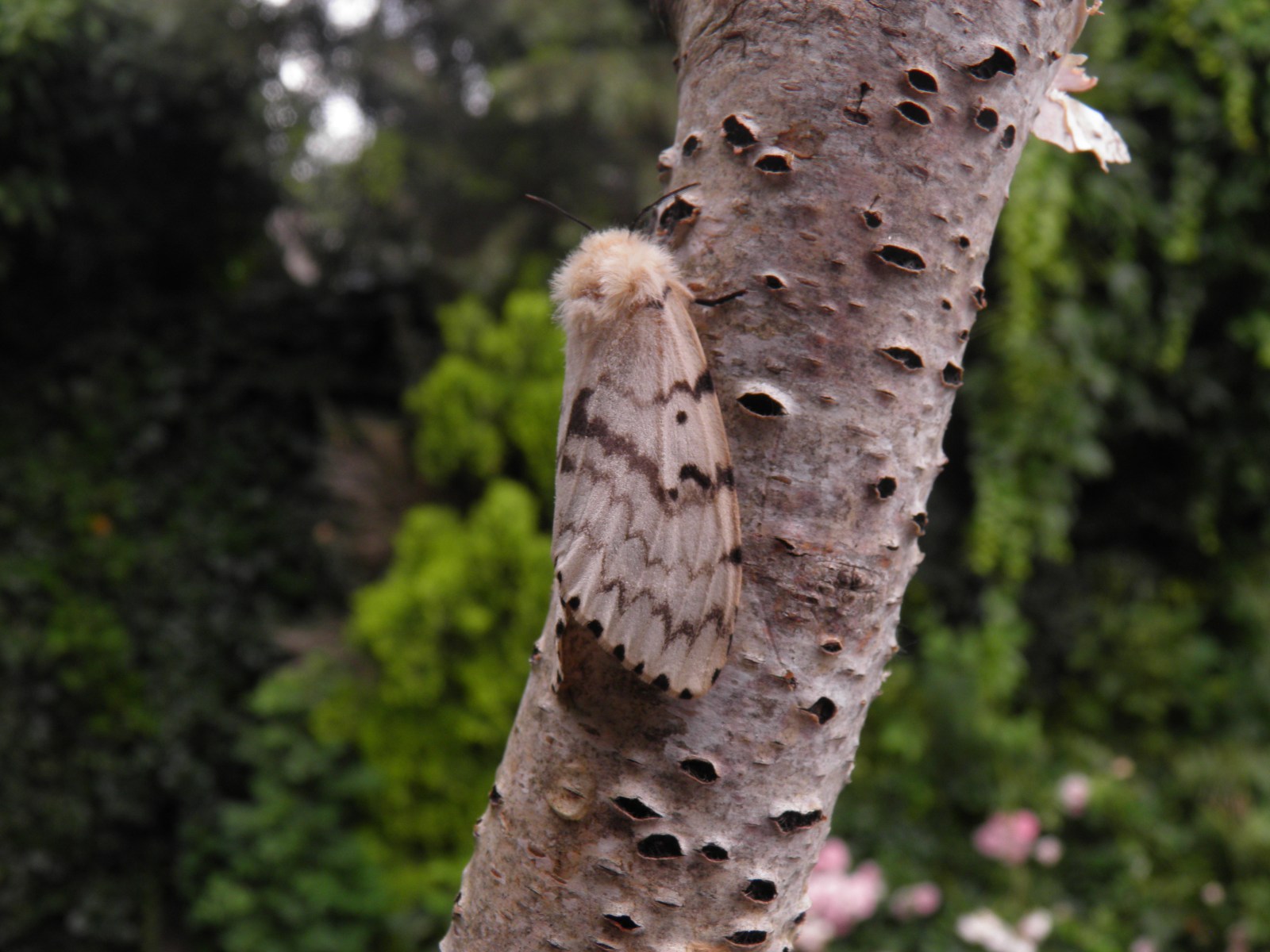Lymantria dispar, also known as the Gypsy moth, is a very prominent species of tussock (Erebidae, Lymantriinae) moth that is commonly found in it’s natural range that covers Europe, northern Africa, southern Asia and parts of Russia; they are often found in temperate forests, wooded areas, shrubs and hedges but they are also able to survive in urbanised areas suchs as parks and gardens. Caterpillars of Lymantria dispar have a very polyphagous and generalised diet and have been recorded to eat the leaves of over hundreds of plant species. It prefers deciduous trees found in the palearctic realm such as oaks (Quercus), willow (Salix), poplar (Populus), lime (Tilia), cashew (Pistachia), birch (Betula), sweetgum (Liquidambar), several types of Rosaceae, mainly fruit trees such as apple (Malus), pear (Pyrus), cherry (Prunus) but also hawthorn (Crataegus). Interestingly it can also eat coniferous trees and can eat pine (Pinus), hemlock (Tsuga), spruce (Picea) cypress (Chamaecyparis) and many other kinds of conifers. Despite their broad range of host plants, their favorite and most important host plant by far is oak (Quercus) and for that reason alone the moth is commonly associated with all types of forests and woodlands that are rich in oak – and chances are high that if oak is present in the area the majority of the larvae will be found upon oak.
In Europe, Africa and Asia the moth is prone to outbreaks in warm years. However, these outbreaks are not harmful since the populations always collapse after a few years because of parasites, viruses, competition, predation and other factors. In fact, Lymantria dispar has a very significant and important role in forest ecosystems.
Lymantria dispar has proven to be a destructive invasive species in the United States of America, where it was accidently released by humans. Since their introduction, this species of moth has done irreparable damage to many native forests in America by defoliating all the trees, sometimes for multiple consecutive years, denying the host plants a chance to recover from the non stop defoliation and killing said trees in the process. Where inside it’s native range the populations are suppressed by numerous diseases, predators and parasitoids, they lack these enemies in America, where they are free to expand their range year after year, and compete with other native species. It’s great degree of polyphagy, as mentioned earlier on this page, is probably one of the main contributing factors to their succes. Lymantria dispar is able to ultimately occupy virtually all portions of the temperate world because they can survive in nearly any type of temperate wooded/forest habitat, where they can utilise hundreds of types of plants. It was introduced on purpose: “The gypsy moth (Lymantria dispar) was introduced in 1868 into the United States by Étienne Léopold Trouvelot, a French scientist living in Medford, Massachusetts. Because native silk-spinning caterpillars were susceptible to disease, Trouvelot imported the species in order to breed a more resistant hybrid species. Some of the moths escaped, found suitable habitat, and began breeding. The gypsy moth is now a major pest of hardwood trees in the eastern United States”
The males of Lymantria dispar are much smaller (30mm-50mm) than the females. They are brown and have very large and noticable antennae. They are active during the day and can be commonly seen patrolling the area, flying in a zig-zag like motion. Flying this way allows them to pick up pheromone trails emitted by females more easily, and their unpredictable flight also makes it harder for predators to capture them. They will quickly locate females and copulate with them.
Females of Lymantria dispar are large (50mm-70mm) and white and are decorated with black stripes and dots. The females can be flightless depending on their geographic origin; some populations have females with underdeveloped flight muscles that literally make them unable to fly. However, most Asian/Eastern populations have females that can in fact fly. When fertilised, females lay large egg cases containing 100 to 1000 eggs, mainly depending on the size and vitality of the female. The egg masses are covered with special hairs from her abdomen, that help camouflage them and protect them from enemies and the elements. Eggs overwinter and take 7 to 9 months to hatch.
- Difficulty rating Simple (Easy to breed)
- Rearing difficulty: 4.5/10 (From egg to pupa)
- Pairing difficulty: 2/10 (Archieving copulations)
- Host plants: 500+ host plants including but not limited to oaks (Quercus), willow (Salix), poplar (Populus), lime (Tilia), cashew (Pistachia), birch (Betula), sweetgum (Liquidambar), (Malus), pear (Pyrus), cherry (Prunus), hawthorn (Crataegus), pine (Pinus), hemlock (Tsuga), spruce (Picea) cypress (Chamaecyparis). Oak is the most important host plant.
- Natural range: Palearctic realm – Europe, Southern Asia, Russia, Northern Africa
- Polyphagous: yes
- Generations: Univoltine (one generation)
- Family: Erebidae – Lymantriidae (tussock moths)
- Pupation: Cocoon (silk encasing)
- Prefered climate: Temperate – northern hemisphere
- Special notes: This moth is being studied intensively by scientists in attempts to understand the fluctuations in their populations and find out ways to control them as invasives.
- Estimated wingspan: 30mm-70mm
- Binomial name: Lymantria dispar (Linnaeus, 1758)
The eggs of Lymantria dispar are laid together in clusters and covered with a layer of special hairs. These hairs come from the abdomen of the female, that she rubs agains the eggs as she lays them. With each egg she lays, she also secretes a little bit of adhesive – a glue-like substance. This adhesive is responsible for keeping the eggs together and glued to the surface, but also for attaching the hairs as she rubs her abdomen over them. Each egg cluster consists of 100 to 1000 eggs depending on the size and vitality of the female.
The eggs of Lymantria dispar overwinter and take 7 to 9 months to hatch. Interestingly it only takes the caterpillars one month to completely develop inside their eggshells, but the larvae can lay dormant before hatching for a very long time. The trigger for hatching is often an increase in temperatures after a prolonged period of cold; this tells them winter has passed.
Interestingly, a very, very small percentage of egg clusters will hatch the very same year in summer, before winter has arrived. These caterpillars are doomed and have no chance of surviving the winter. The reason why this happens remains a mystery, but I speculate that this is a survival mechanism that allows the moths to produce a second generation if the conditions would somehow allow this. Should they conquer new territories with very mild winters or should the climate shift in a way that allows them to produce a second generation before winter. This is however a rare and unusual occurence.
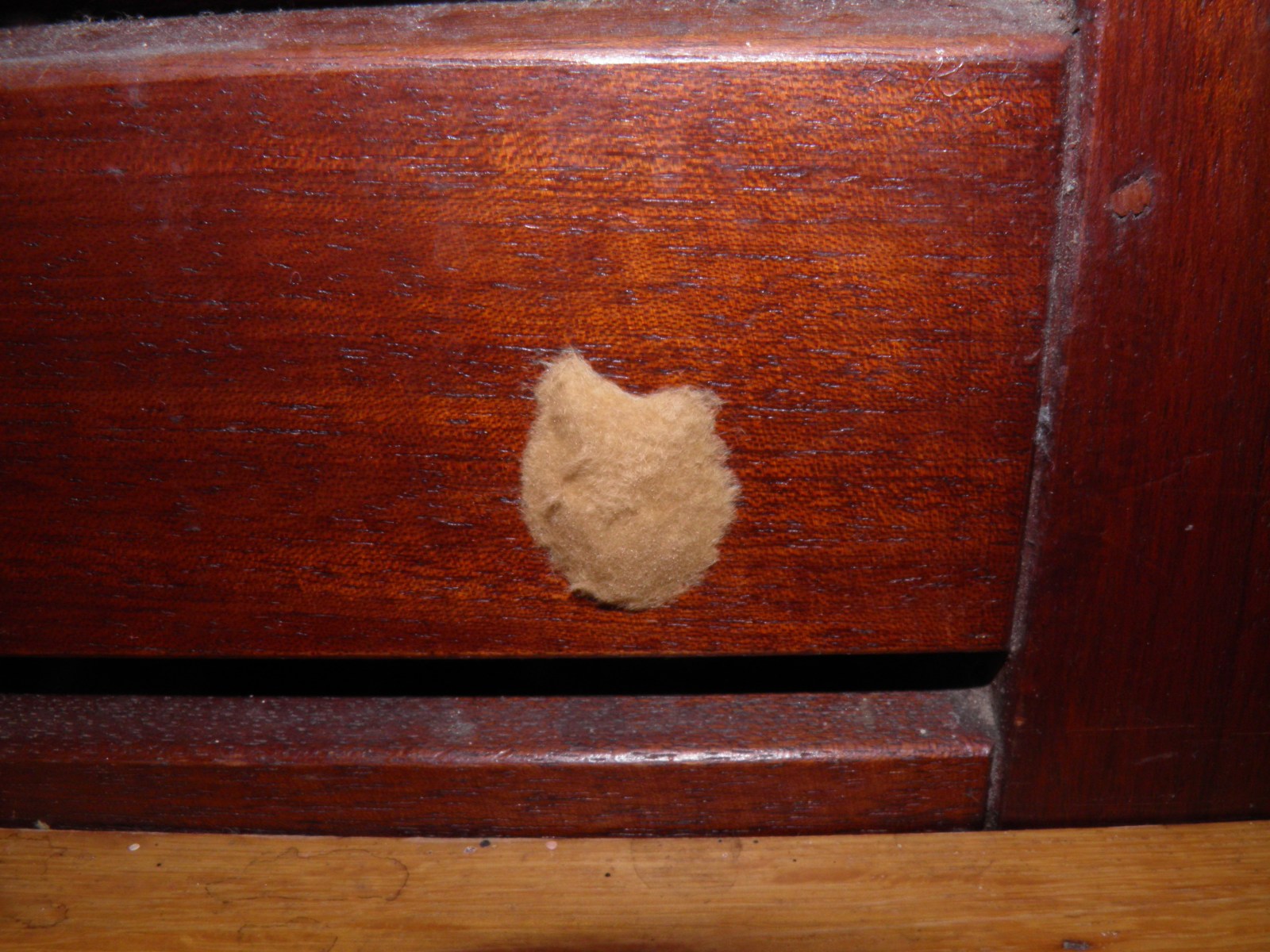 Lymantria dispar egg cluster on a window
Lymantria dispar egg cluster on a window
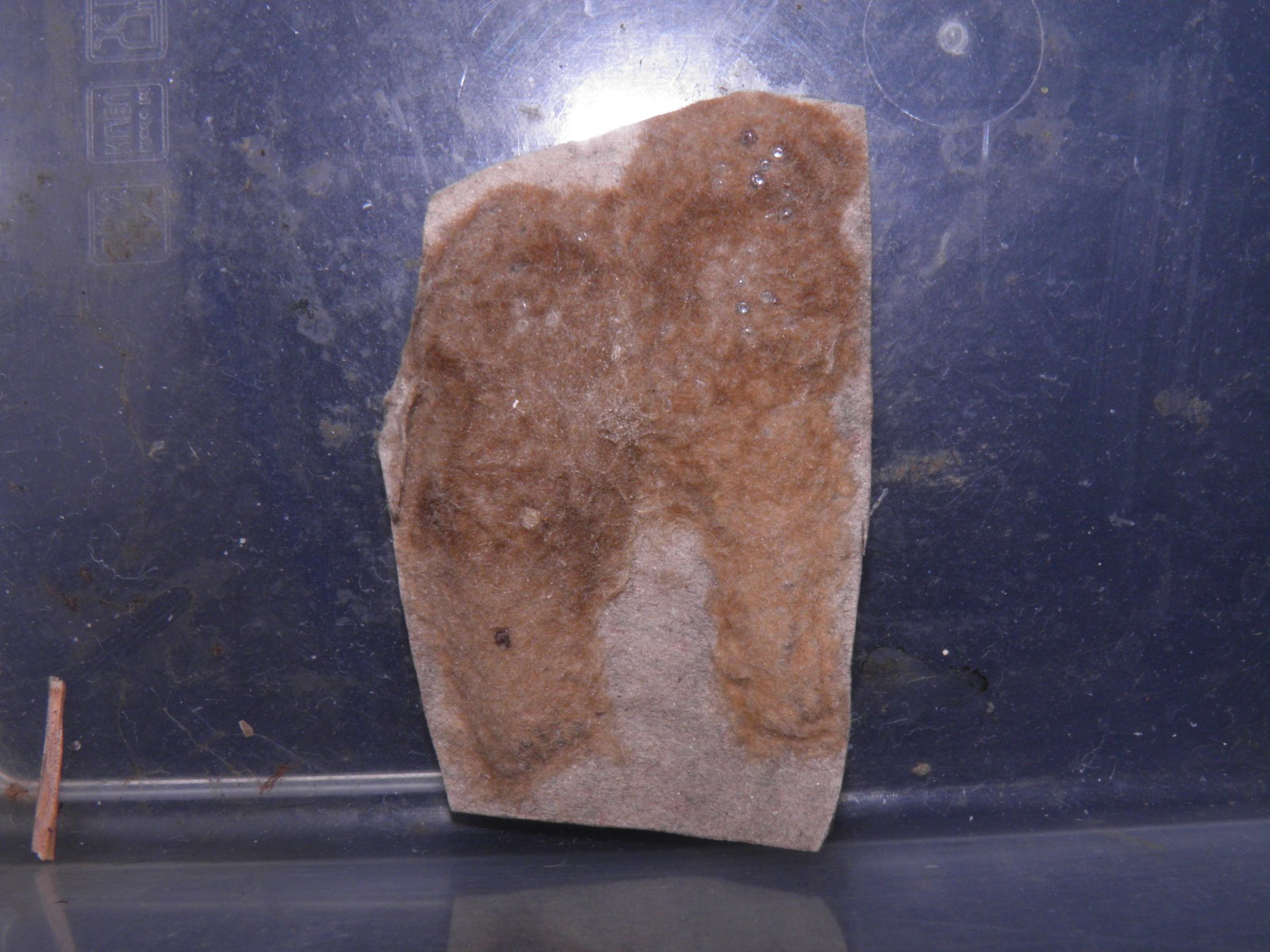 Two egg clusters of Lymantria dispar, laid on carboard
Two egg clusters of Lymantria dispar, laid on carboard
Young, recently hatched caterpillars show strong phototaxis and are very attracted to (UV)light. This motivates them to climb up high in the treetops and disperse. The caterpillars disperse themselves by the wind, by hanging unto a silk thread, a phenomenon known as ‘ballooning’ (often used in reference to spiders that use their silk to disperse themselves by the wind).
 Hundreds of caterpillars hatching from an egg cluster
Hundreds of caterpillars hatching from an egg cluster
Aftering finding a place to settle down – usually high up in the shrubbery or treetops – the young larvae begin to eat. In captivity they can be raised in plastic boxes or in rearing sleeves. They require a little bit of ventilation and sufficient fresh food.
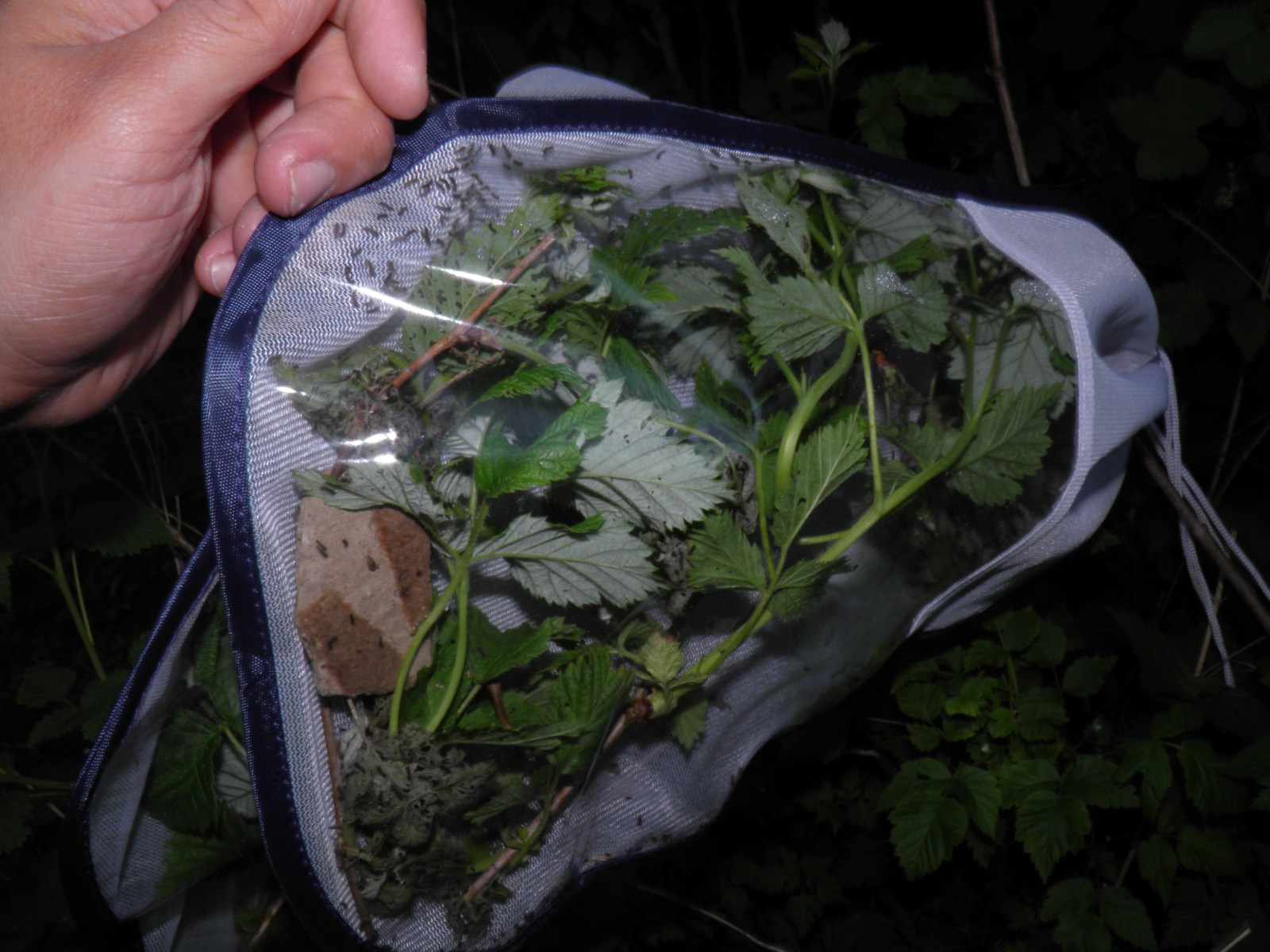 Lymantria dispar sleeve around Rubus idaeus
Lymantria dispar sleeve around Rubus idaeus
Caterpillars become hairy and have two rows of colourful blue tubercules around their thorax and orange tubercules and patches on their abdominal segments. They can be raised on nearly all kinds of deciduous trees and shrubs found in the palearctic realm. The caterpillars of Lymantria dispar live solitary, but they can tolerate eachother in high densities.
 Young larva of Lymantria dispar
Young larva of Lymantria dispar
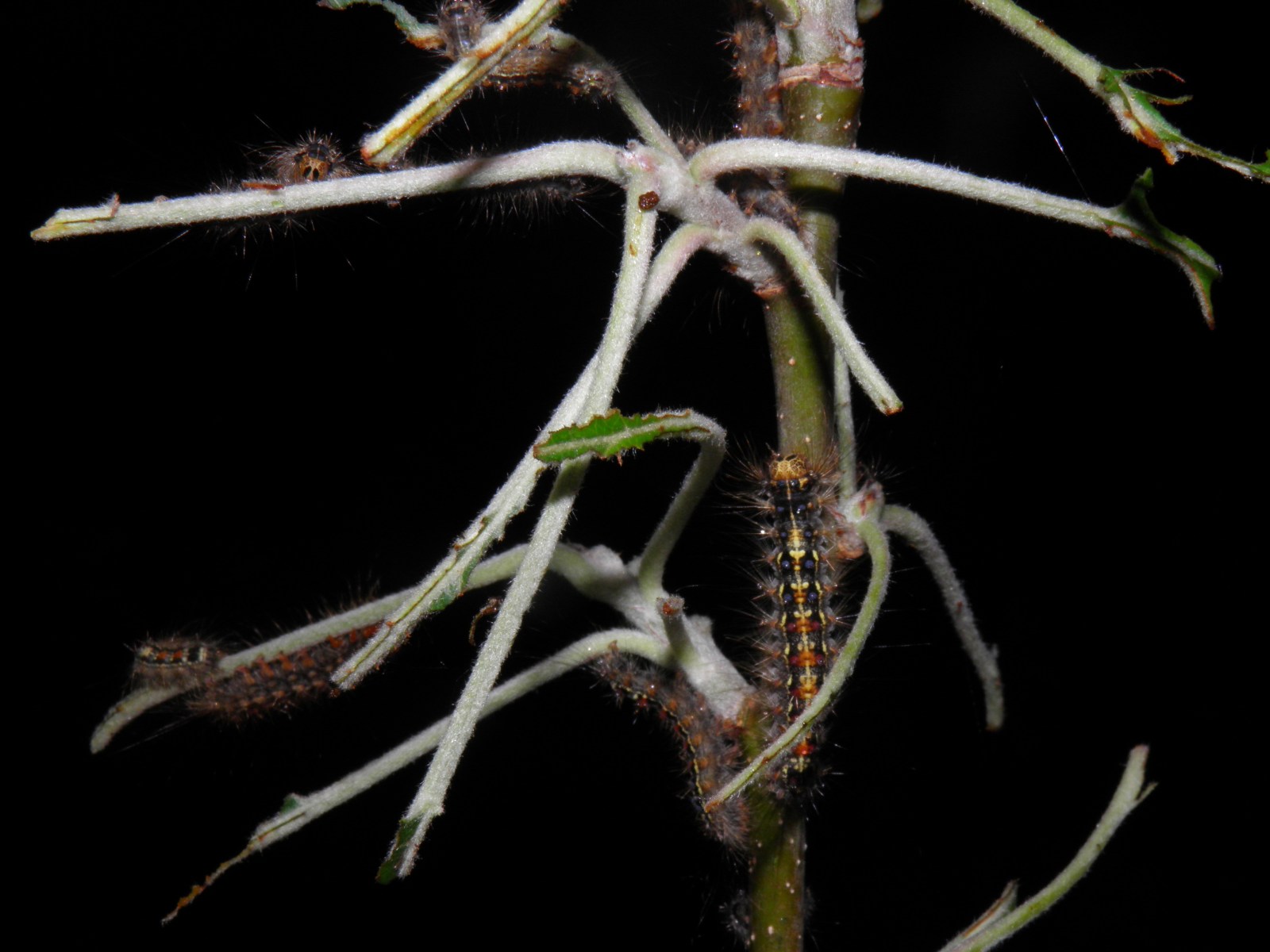 Raising Lymantria dispar on apple (Malus)
Raising Lymantria dispar on apple (Malus)
The hairs of Lymantria dispar are not known to be very harmful, but they can still cause rashes or irritations on the skins or in the lungs of the most sensitive people. Caterpillars of Lymantria dispar start feeding in the treetops when they are young, but bigger larvae descend to the lower tree trunks and can be found resting against the tree bark. Sometimes they congregate in cavities such as tree trunks or bird nests to pupate or shed their skins. Fully grown caterpillars also mainly feed at night and hide during the day.
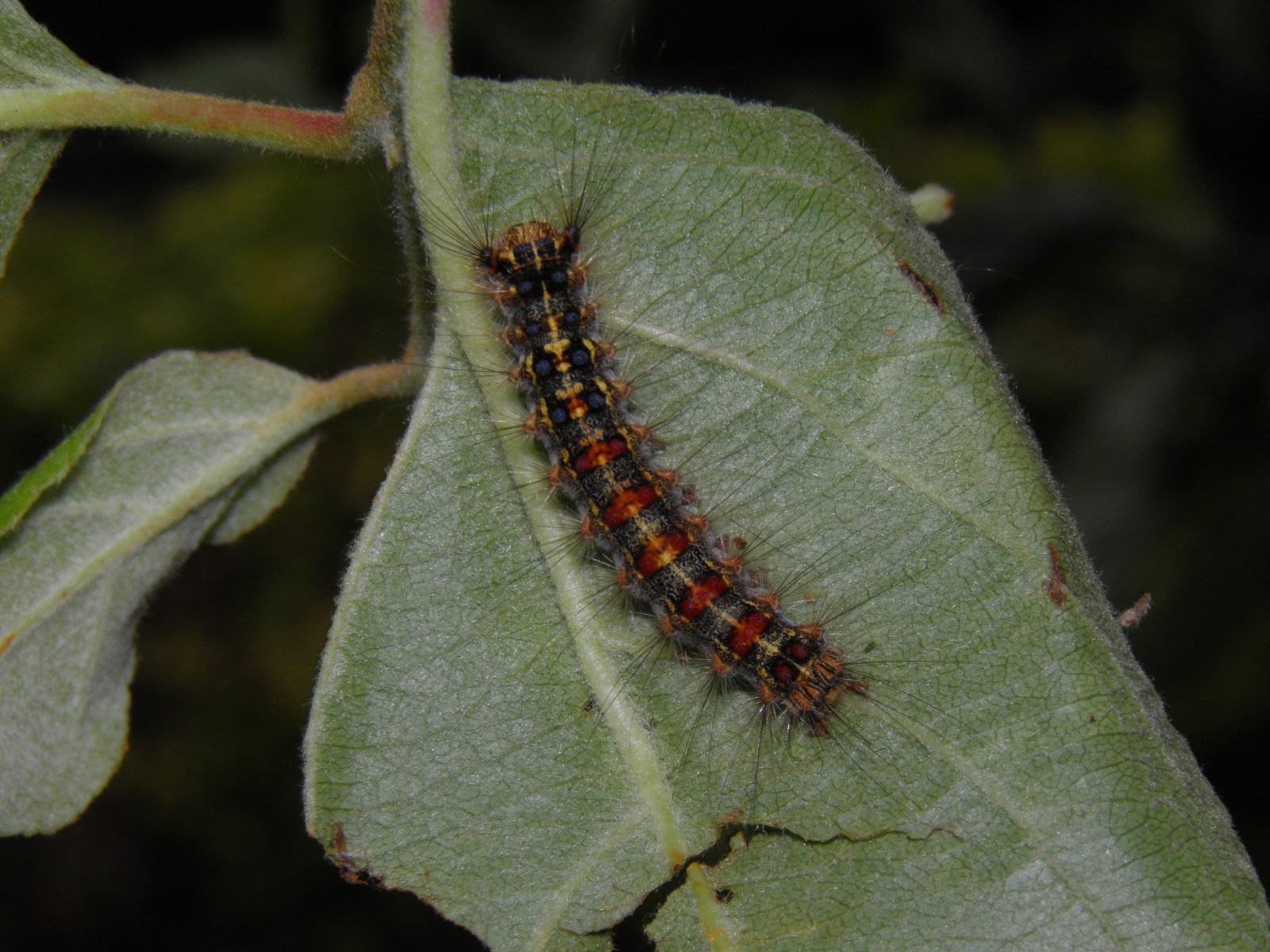 Final instar of Lymantria dispar
Final instar of Lymantria dispar
 Rearing sleeves of Lymantria dispar on apple
Rearing sleeves of Lymantria dispar on apple
 Final instar of Lymantria dispar
Final instar of Lymantria dispar
Caterpillars of Lymantria dispar become quite big – by European standards – growing up to a size of 60mm. Male caterpillars are smaller than female caterpillars, for the body mass of females is much greater. When they are ready to pupate, they spin a very lazy cocoon, that is perhaps too minimalistic to be labeled as a cocoon at all. Usually, they fold the leaves of their host plants together with silk and pupate within the small cavity that is formed. However, in some cases the pupae are just loosely attached to the vegetation by a few strings of silk. Depending on the local temperatures, caterpillars of Lymantria dispar can be fully grown in 1.5 to 5 months time. Warmth significantly speeds up their growth and development, but in more cold and unfavourable conditions the caterpillars can survive for a long time, growing more slowly. In optimal and warm conditions they can pupate twice as fast as in cold conditions out of their comfort zone.
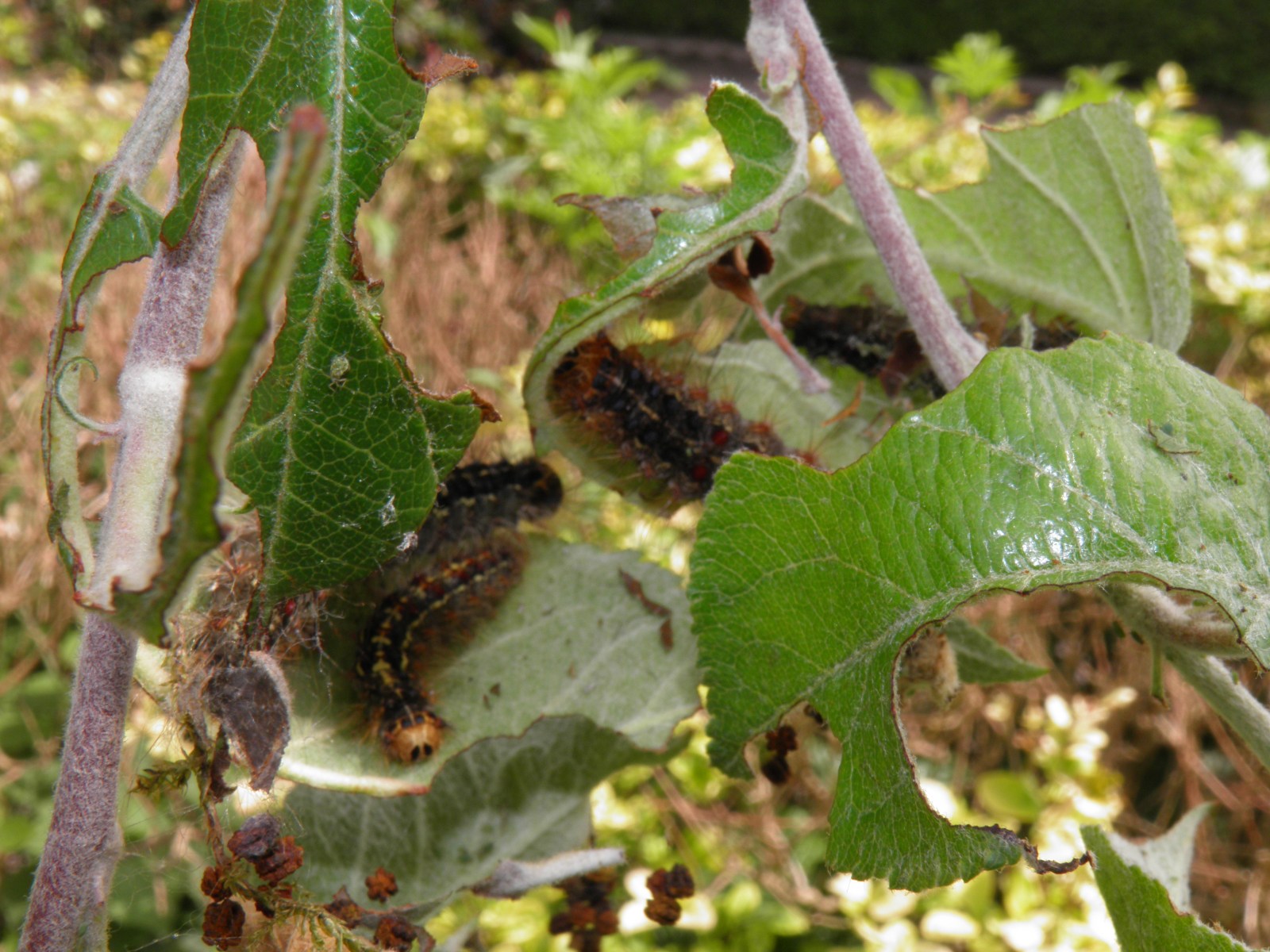 Lymantria dispar pupating among the leaves
Lymantria dispar pupating among the leaves
The pupae of Lymantria dispar are exposed to the environment in a high degree. A typical Lymantria dispar ‘cocoon’ actually just consists of a few silk threads that attach the pupa to the vegetation, and in some cases, fold the leaf to create a cavity for the pupa. In some cases they pupate in plain sight. However, it makes sense that Lymantria dispar does not invest a lot of energy in spinning cocoons; their pupal stage only lasts for a few weeks. Pupating in early/mid summer, the pupae face comfortable and warm conditions. They merely need 2 to 4 weeks before hatching.
 A typical Lymantria dispar ‘cocoon’ – that actually just consists of a few silk threads attaching the pupae to the vegetation, and in some cases, fold the leaf to create a cavity for the pupa
A typical Lymantria dispar ‘cocoon’ – that actually just consists of a few silk threads attaching the pupae to the vegetation, and in some cases, fold the leaf to create a cavity for the pupa
The female pupae of Lymantria dispar are easy to sex, for they are much bigger and heavier than the male pupae. They also have a thick, round abdomen. Male pupae are small and have broad antennae. The pupae of Lymantria dispar are hairy and have a few small yellow tufts of hair.
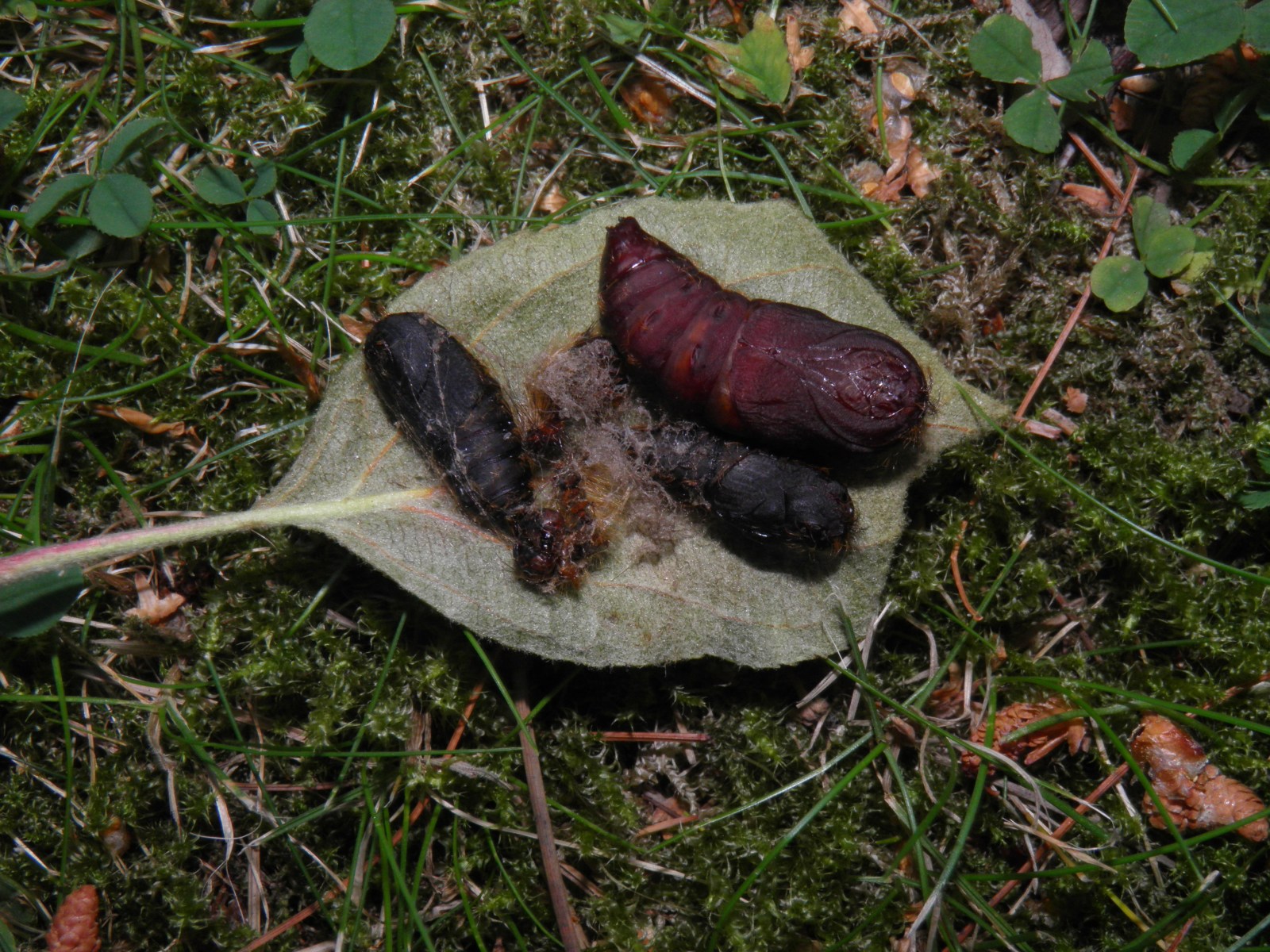 Lymantria dispar; one female and two small male pupae together
Lymantria dispar; one female and two small male pupae together
Adults of Lymantria dispar are very easy to sex. Females are white and twice as big as the male. Males are small and brown. Males have huge, noticable antennae where females have two small, ropelike antennae. The males of Lymantria dispar are day active and patrol the area in the afternoon. Their flight is very erratic and unpredictable, flying in a chaotic zig-zag like pattern. Once they smell a female, they are quick to respond and land beside here in order to pair. The copulation lasts one to multiple hours. Females from the same brood tend to hatch a little later than the males.
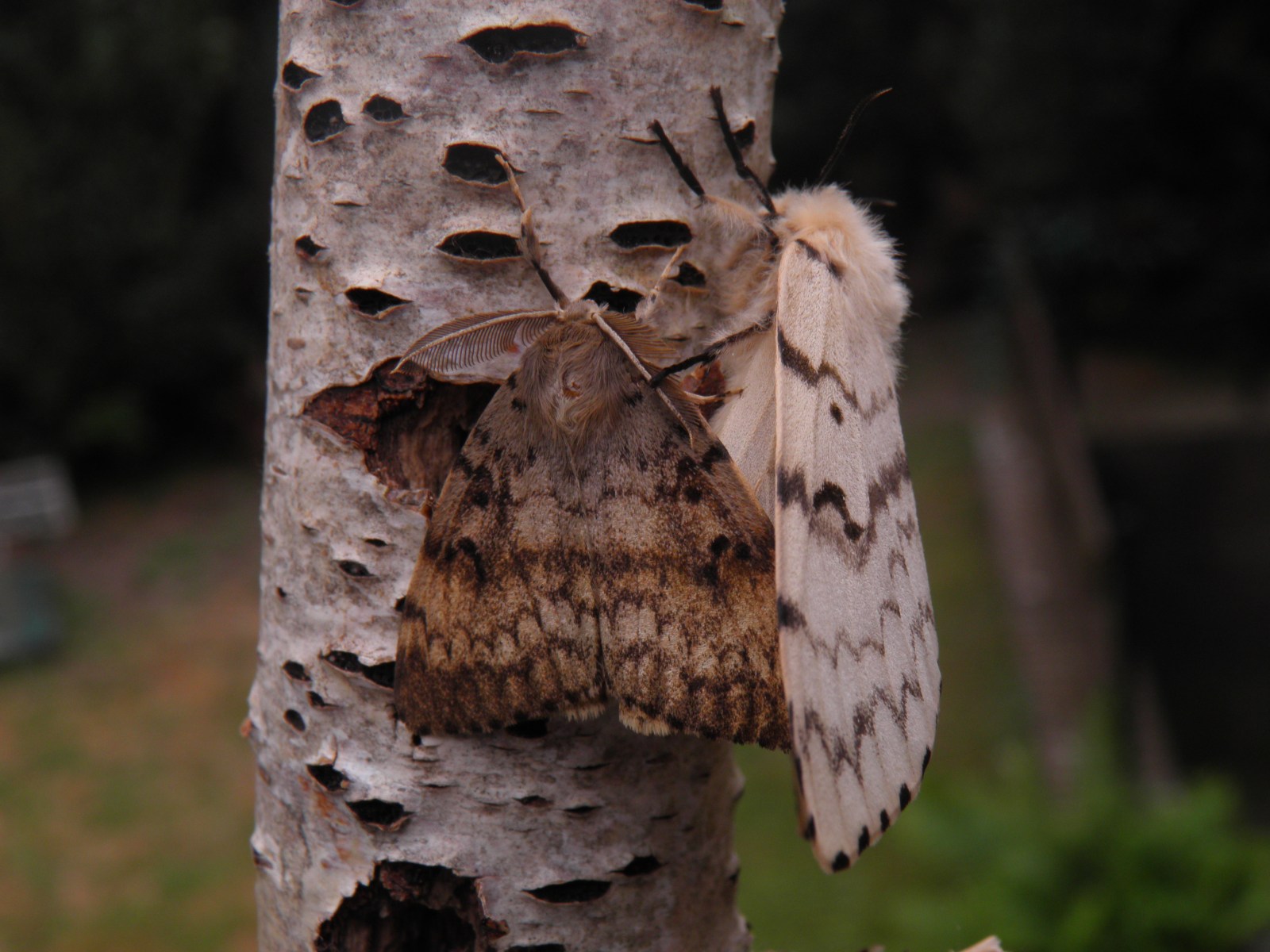 Copulation of Lymantria dispar
Copulation of Lymantria dispar
 Copulation of Lymantria dispar
Copulation of Lymantria dispar
Flightless or not?
The females of Lymantria dispar from most parts of Europe have underdeveloped flight muscles. This literally makes them unable to fly. However, it appears that this is because of a mutation that is not present in all populations. The Eastern populations from East Germany/Balkans/Asia and beyond seem to have females that are capable of flight. Furthermore, the ability to fly seems to be a heritable trait in Lymantria dispar. The fact remains that some populations have flying females and some have not! It seems that the mutation that renders females incapable of flight does not really impair the ability of this species to survive. Caterpillars can easily disperse by the wind; female flight is not required for this species to expand it’s range. Thus, being flightless is does not give them a disadvantage, and the trait is maintained in the population and passed on to the offspring. This may be the evolutionary pathway that enables brachypterism in Lepidoptera. Mutations with seemingly no negative effects on the survival of the animal can persist, even if it disables some of their bodily functions; gradually these functions may be lost. See also: loss of eyes and pigmentation in endemic cave fish and salamanders.
Three prominent types of gypsy moths can be found across the world.
The European gypsy moth, Lymantria dispar dispar.
The Asian gypsy moth, Lymantria dispar asiatica.
The Japanese gypsy moth, Lymantria dispar japonica.
These are called subspecies and show subtle differences, even if they are the same species.
The European gyspy moth, L. dispar dispar, is found in Europe and a small part of western Asia. L. dispar dispar is the subspecies that has fightless females with reduced flight muscles, although this is a heritable trait and not present in all populations. The vast majority are, however, flightless.
The Asia gypsy moth, Lymantria dispar asiatica, is found east from the Ural mountains and parts of eastern Russia, China, Korea, and other parts of temperate Asia. The females have the ability to fly, and they are bigger. – Quote ” Schintlmeister treated L. dispar asiatica as a synonym of L. dispar dispar on the basis of their type locality; however, Pogue and Schaefer treated the subspecies as valid based on the morphological characteristics of the females, which have larger wings than the females of L. dispar dispar(Lee et al., 2015; Pogue & Schaefer, 2007; Schintlmeister, 2004). The dispersal ability of the two subspecies may differ because of these differences in wing size”
The Japanese gypsy moth, Lymantria dispar japonica, has much bigger and dark males, and is generally the biggest subspecies, and is found in Japan. Females fly very well. The status of this subspecies is unknown, as it appears that each island in Japan may contain its own unique subspecies; L. d. obscura from Lake Biwa and Gifu region, Honsu, Japan, the L. d. tsushimensis from Kubara, Tsushima, Japan, and the L. d. postalba from Yakushima, Japan, and L. d. hokkaidoensis from Hokkaido. It remains unclear how these subspecies relate to eachother, but interbreeding has demonstrated partial incompatibility or mortality. More research is needed.
In America the species is not native and invasive, but mainly only the European gypsy moth is found there (L. dispar dispar). However, since very recently the Asian gypsy moth (L. dispar asiatica) has been found there too, which may be a concerning development. While they are both the same species on paper, the Asian subspecies is bigger, and females are better at flying, and thus, there is a chance this subspecies is even better at expanding the range it occupies in territories where it is invasive.
In Europe it is also a forest pest, and while the populations can damage forest habitats in some cases, the species is of less concern. In the forests where the moth is native, many other species will know how to hunt them – wasps, birds, parasitic flies, assasin bugs but also pathogens such as viruses and bacteria will capitalise and thrive because the high number of caterpillars (easy food!) and eventually bring the population down to a manageable level.
Thank you for reading my article. This is the end of this page. Below you will find some useful links to help you navigate my website better or help you find more information that you need about moths and butterflies.
Dear reader – thank you very much for visiting! Your readership is much appreciated. Are you perhaps…. (see below)
-
-
- Not done browsing yet? Then click here to return to the homepage (HOMEPAGE)
- Looking for a specific species? Then click here to see the full species list (FULL SPECIES LIST)
- Looking for general (breeding)guides and information? Then click here to see the general information (GENERAL INFORMATION)
- Interested in a certain family? Then click here to see all featured Lepidoptera families (FAMILIES)
-
Citations: Coppens, B. (2019); Written by Bart Coppens; based on a real life breeding experience [for citations in literature and publications]
Was this information helpful to you? Then please consider contributing here (more information) to keep this information free and support the future of this website. This website is completely free to use, and crowdfunded. Contributions can be made via paypal, patreon, and several other ways.
All the funds I raise online will be invested in the website; in the form of new caresheets, but also rewriting and updating the old caresheets (some are scheduled to be rewritten), my educational websites, Youtube, breeding projects, the study of moths andconservation programs.
Donate button (Liberapay; credit card and VISA accepted)
Donate button (PayPal)
![]()
Become a member of my Patreon (Patreon)
![]()
Find me on YouTube

Find me on Instagram
![]()
Join the Discord server: Click here
Join the Whatsapp server: Click here
Buy insect cocoons: Click here
Facebook: Click here
.


